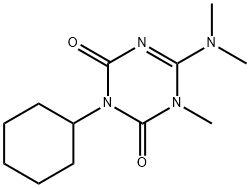
Hexazinone
- русский язык имя
- английское имяHexazinone
- CAS №51235-04-2
- CBNumberCB7319547
- ФормулаC12H20N4O2
- мольный вес252.31
- EINECS257-074-4
- номер MDLMFCD00055526
- файл Mol51235-04-2.mol
| Температура плавления | 97-100.5° |
| Температура кипения | 395.49°C (rough estimate) |
| плотность | 1.2500 |
| показатель преломления | 1.6120 (estimate) |
| Fp | 11℃ |
| температура хранения | APPROX 4°C |
| растворимость | Chloroform (Slightly), Ethyl Acetate (Slightly, Heated) |
| пка | 2.05±0.70(Predicted) |
| форма | Powder |
| цвет | Beige |
| Растворимость в воде | 33g/L(25 ºC) |
| БРН | 618801 |
| Справочник по базе данных CAS | 51235-04-2(CAS DataBase Reference) |
| Рейтинг продуктов питания EWG | 2 |
| FDA UNII | Y51727MR1Y |
| Справочник по химии NIST | 1,3,5-Triazine-2,4(1h,3h)-dione, 3-cyclohexyl-6-(dimethylamino)-1-methyl-(51235-04-2) |
| Система регистрации веществ EPA | Hexazinone (51235-04-2) |
| Пестициды Закон о свободе информации (FOIA) | Hexazinone |
| UNSPSC Code | 41116107 |
| NACRES | NA.24 |
| Коды опасности | Xn,N,T,F | |||||||||
| Заявления о рисках | 22-36-50/53-39/23/24/25-23/24/25-11 | |||||||||
| Заявления о безопасности | 60-61-45-36/37-16-7 | |||||||||
| РИДАДР | UN3077 9/PG 3 | |||||||||
| WGK Германия | 3 | |||||||||
| RTECS | XY7850000 | |||||||||
| кода HS | 29336990 | |||||||||
| Банк данных об опасных веществах | 51235-04-2(Hazardous Substances Data) | |||||||||
| Токсичность | LD50 orally in rats: 1690 mg/kg (Neary) | |||||||||
| NFPA 704: |
|
рисовальное письмо(GHS)
-
рисовальное письмо(GHS)


-
сигнальный язык
предупреждение
-
вредная бумага
H319:При попадании в глаза вызывает выраженное раздражение.
H302+H332:Вредно при проглатывании или при вдыхании.
H410:Чрезвычайно токсично для водных организмов с долгосрочными последствиями.
-
оператор предупредительных мер
P261:Избегать вдыхания пыли/ дыма/ газа/ тумана/ паров/ аэрозолей.
P264:После работы тщательно вымыть кожу.
P273:Избегать попадания в окружающую среду.
P301+P312:ПРИ ПРОГЛАТЫВАНИИ: Обратиться за медицинской помощью при плохом самочувствии.
P304+P340+P312:ПРИ ВДЫХАНИИ: Свежий воздух, покой. Обратиться за медицинской помощью при плохом самочувствии.
P305+P351+P338:ПРИ ПОПАДАНИИ В ГЛАЗА: Осторожно промыть глаза водой в течение нескольких минут. Снять контактные линзы, если Вы ими пользуетесь и если это легко сделать. Продолжить промывание глаз.
Hexazinone химические свойства, назначение, производство
Использование
Hexazinone is a triazine compound used as a preemergence or postemergence herbicide to control many annual grasses and broad-leaved weeds in noncropped land and certain crops such as alfalfa, blueberries, coffee, pecans and sugarcaneМетоды производства
Hexazinone is a postemergence contact herbicide effective against many annual and biennial weeds and, except for Johnson grass, most perennial weeds. Human contact is likely at the use stage, and dermal contact and inhalation are of most concern.Общее описание
White crystalline solid. Corrosive eye irritant. Used as an herbicide.Реакции воздуха и воды
Water soluble. Rapidly decomposed in solution by strong acids and bases.Профиль реактивности
A triazine.Канцерогенность
No carcinogenicity was detected among pups of rats fed up to 5000 ppm for 2 years. Similarly, no increase in tumors was produced by feeding up to 10,000 ppm hexazinone to mice.Экологическая судьба
Soil/Plant. Biodegrades in soil and natural waters releasing carbon dioxide. The reported half-life in soil is 1 to 6 months (Hartley and Kidd, 1987). Rhodes (1980a) found that the persistence of hexazinone varied from 4 weeks in a Delaware sandy loam to 24 weeks in a Mississippi silt loam.Hexazinone is subject to microbial degradation (Rhodes, 1980a; Feng, 1987). Metabolites identified in soils, alfalfa and/or sugarcane include 3-(4-hydroxycyclohexyl)-6(dimethylamino)-1-methyl-1,3,5-triazine-2,4(1H,3H)-dione, 3-cyclohexyl-6-(methylamino)-1
Feng (1987) monitored the persistence and degradation of hexazinone in a silt loam soil 104 days after treatment of the herbicide. After 104 days, 66% of the hexazinone degraded via hydroxylation to form the major metabolite 3-(4-hydroxycyclohexyl)-6(dime
No traces of hexazinone or its metabolites were detected on treated blueberries (Jenson and Kimball, 1985).
Photolytic. Photodegradation products identified in aqueous hexazinone solutions following exposure to UV light (λ = 300–400 nm) were 3-(4-hydroxycyclohexyl)-6-(dimethylamino)-1-methyl-1,3,5-triazine-2,4(1H,3H)-dione, 3-cyclohexyl-6-(methylamino)
Метаболический путь
In clay and sand soils, hexazinone is metabolized by hydroxylation at the 4-position of the cyclohexane ring and mono-N-demethylation to give [3-(4- hydroxycyclohexyl)-6-(dimethylamino)-1-methyl-1,3,5- triazine-2,4-(1H,3H )-dione], and [3-cyclohexyl-6- (methylamino)-1-methyl-1,3,5-triazine-2,4-(1H,3H )- dione, respectively. N-Demethylated metabolite is found in a comparatively higher percentage than the hydroxylated metabolite in both clay and sand soils.Hexazinone запасные части и сырье
Hexazinone поставщик
| поставщик | телефон | страна | номенклатура продукции | благоприятные условия |
|---|---|---|---|---|
| +8613573296305 | China | 301 | 58 | |
| +86-371-86557731 +86-13613820652 |
China | 20259 | 58 | |
| +86-0371-55170693 +86-19937530512 |
China | 21632 | 55 | |
| 18871490254 | CHINA | 28172 | 58 | |
| +86-86-5926051114 +8618959220845 |
China | 6383 | 58 | |
| +86-023-6139-8061 +86-86-13650506873 |
China | 39894 | 58 | |
| +8618523575427 | China | 49732 | 58 | |
| +86-0371-86658258 +8613203830695 |
China | 29809 | 58 | |
| +86-13806087780 | China | 17365 | 58 | |
| +1-781-999-5354 +1-00000000000 |
United States | 32161 | 58 |